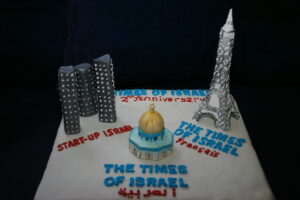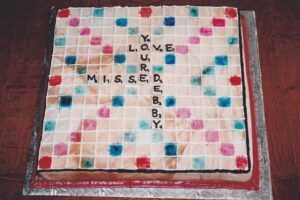One of the fundamental themes of Purim is that everything can change in an instant – ונהפוך הוא – particularly if God is standing behind you.
In the vein of topsy turvydom, here’s another in the series of ambigram cakes which read the same right side up and upside down. Happy Purim!
The results are in! Last week I wondered why Jewish texts frequently sport colourful splotchy page ends and the public has responded.  Many thanks to Rachel Madar, Sarah Bronson, John Atlas and Rachel Jacobson who supplied the following answers:
Many thanks to Rachel Madar, Sarah Bronson, John Atlas and Rachel Jacobson who supplied the following answers:
- When the technology of printing began, it was very hard to get batches of paper to consistently come out the same color. So books would show differently coloured pages. The ink at the bottom was a decorative feature intended to hide this. Most books at the time had it, and it stayed with religious books because of… tradition!
- It seems that staining the edges prevents the pages from turning brown over time due to the accumulation of dust.
- Traditionally they color the edges so the dust won’t show. Pretty useless in the Middle East, where you can hermetically seal something in five layers of the latest industrial plastic and it’ll be dusty within a week.
Order this Cake Now
(9722) 563-9668








